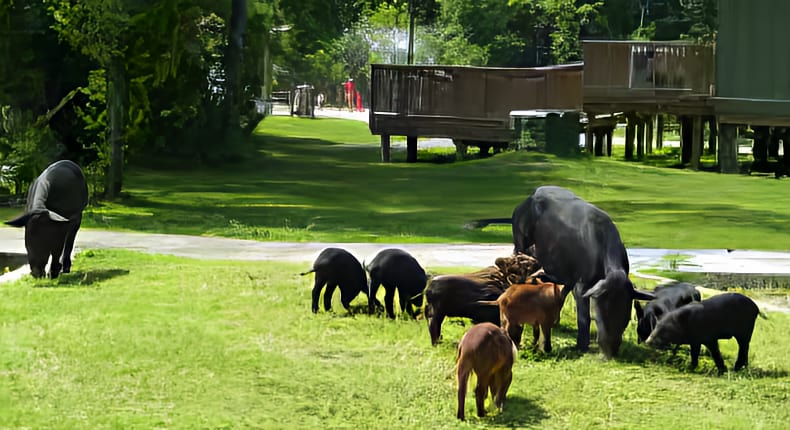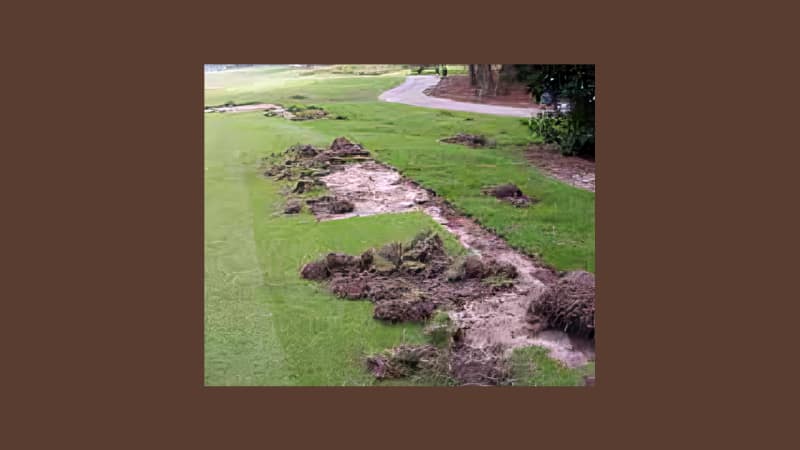Feral Swine Damage to a Golf Course
Backstory
Recently we reported [go here] that “on Saturday, April 29, 2023, a Villager reported sighting a drove of 10 or 11 pigs roaming loose in the Village. Witnesses reported acts of aggression and damage to common property was observed.”
Six Village Police and Animal Control Officers responded to the call for help. The swine became aggressive when officers attempted to keep them in one area. Unable to procure help from other entities or determine if someone owned the swine, it was thought they were feral because of the aggression.
Due to dangers and other problems associated with wild swine, the Officers put the animals down as humanely as possible using their best judgment with known facts.
Problems and Dangers Caused by Wild Swine
The harm caused by wild swine is extensive and far-reaching, with populations throughout the United States and few natural predators; this invasive species seriously impacts everything from agriculture and the environment to human health and public safety.
Females begin mating at approximately eight months and may have two litters of four to twelve piglets every 12 to 16 months, possibly resulting in a rapid herd increase.

When in roadways or airports, feral swine can collide with vehicles and aircraft, putting the safety of drivers, pilots, and passengers at risk.
Other public safety risks arise when feral swine are in urban and suburban areas. As they become less afraid of people, they have shown aggression toward golfers, picnickers, and others. This behavior is more of a problem when they associate people with food because of handouts and improper waste disposal. In addition, feral swine may be aggressive to dogs and other pets.
If feral swine are in the area, they may swiftly derail homeowners’ attempts to preserve and develop their properties. Destroyed vegetation and wallows impair the aesthetic value of private properties, public parks, and recreational spaces. Feral swine foraging, rooting, and wallowing also harms landscaping, golf courses, recreational fields, cemeteries, parks, lawns, other natural places, and wildlife.
Furthermore, adult feral swine weigh between 75 and 250 pounds on average, with some weighing much more. As a result, crashes with automobiles and airplanes can result in injury and severe property damage.
Feral swine have an impact on wildlife as well. Feral pigs and native species compete for crucial and limited natural food supplies such as acorns and other forest tree nuts because their diets overlap. Feral pigs also limit food availability by consuming seeds, plants, and tiny animals (including insects, earthworms, and worms.
Finally, feral pigs can transmit diseases to wildlife, some of which are lethal. The damage they create also increases mosquito habitat, which can lead to an increase in the incidence of avian malaria and avian pox, both of which endanger the health of local birds.
Information compiled by Joe Dowden; Information and photos from the United States Department of Agriculture website.








seems to me that the village did not go far enough to find out who owns the pigs
The first picture above looks more like sod cutting and sod replacement.. Where did the above picture come from?
Cheryl
Doesn’t my comment above carry enough weight to get a reponse from the article’s writer?
Where did the first picture come from as it looks more like the middle part of the maintenace process of sod cutting and replacement.
Steve, thank you for your diligence. Of course your comment carries weight. We are beyond covered up and cannot always respond to everything. It is not that we think comments are not important, it is just that we are very over extended. My husband wrote the article, at my request, so I will answer for him as he is currently working on something else. Here is the link for the photo. https://www.aphis.usda.gov/publications/wildlife_damage/fsc-feral-swine-risks.pdf I just realized the link in the article doesn’t work, so I will take care of that and appreciate you bringing it to my attention. As you can see, the image came straight from a very reputable source, the US Department of Agriculture. Damage from feral swine is well-documented on the internet. If you want more sources, you might want to do a Google search or look on YouTube.
I know I saw a video in the past on YouTube from a news station. I do not remember the details as this was a while back. Sorry for the confusion. Thank you.